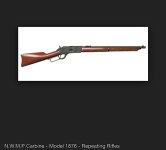Let me add some detail and hopefully clear up some potential confusion.
The 1886 Winchester was developed for the .45-90 WCF with a case length of 2.400” compared to the .45-70 which had a case length of 2.105.”
There was also the .45 2 4/10 Sharps Straight which is more commonly referred to as the .45-90 Sharps.
The external dimensions are exactly the same, the difference is in the load. The .45-90 WCF was typically loaded with a 300 gr lead bullet with a COAL of 2.6” to reliably cycle through the 1886 action. The .45-2 4/10 or .45-2.4, or .45-90 Sharps (whatever you choose to call it) was loaded with a 500 or 550 gr bullet to a longer OAL that would not feed in an 1886.
Similarly, the .45-70 used in the 1886 was the .45-70 Govt, also known as the .45-70-405 for its use of a 405 gr. bullet. However that original round was largely supplanted in infantry service by the .45-70-500 developed in 1879 which had more range. The 1884 Springfield was developed for that round.
In cavalry carbine service the .45-70-405 was supplanted by the .45-55-405 carbine load, which used a cardboard tube in the case or a stack of card wads in the case (depending on who made it) to take up the extra space and allow a reduced 55 gr powder charge.
In short, the whole designation matters (caliber - black powder charge weight - bullet weight) and “.45-70” and “.45-90” isn’t sufficient.
——
The .45-90 is more flexible than the .45-70 in an 1886 as you can usually chamber a .45-70-405 or .45-70-500 in a .45-90 and if it both functions and chambers, it can usually be safely fired in the longer .45-90 chamber. Accuracy however may suffer as the soft lead bullet gets an additional .3” head start and enters the rifling at higher speed, and you can get excessive gas cutting in the longer free bore.
But there’s also a caveat in terms of pressure. The 1886 is a strong action but it was designed for 28,000 CUP /28,000 PSI loads and that’s the same whether it’s a .45-90 or a .45-70.
Post 1972 Marlin Model 1895 .45-70s can be loaded to 40,000 CUP / 45,000 psi.
Ruger No. 1 rifles can be loaded to 50,000 CUP / 60,000 psi.
Using either of the latter two loads in a vintage .45-70 or .45-90 will likely low it up.
—-
In any case if you own a .45-90 and you want to shoot it, you really need to be hand loading .45-90-300 ammo for it.
The difference in velocity between a .45-90 and .45-70 with black powder loads is about 200 fps and much of that is due to the lighter bullet. Paper patching was common in the .45-90 for accuracy and to reduce leading.
In other words, juice isn’t worth the squeeze in a .45-90 lever action. It has some advantages in a single shot for BPCR shooters but for the average person .45-70 will do whatever you need it to do, especially in smokeless powder loads where the .45-90 offers no significant advantage.




